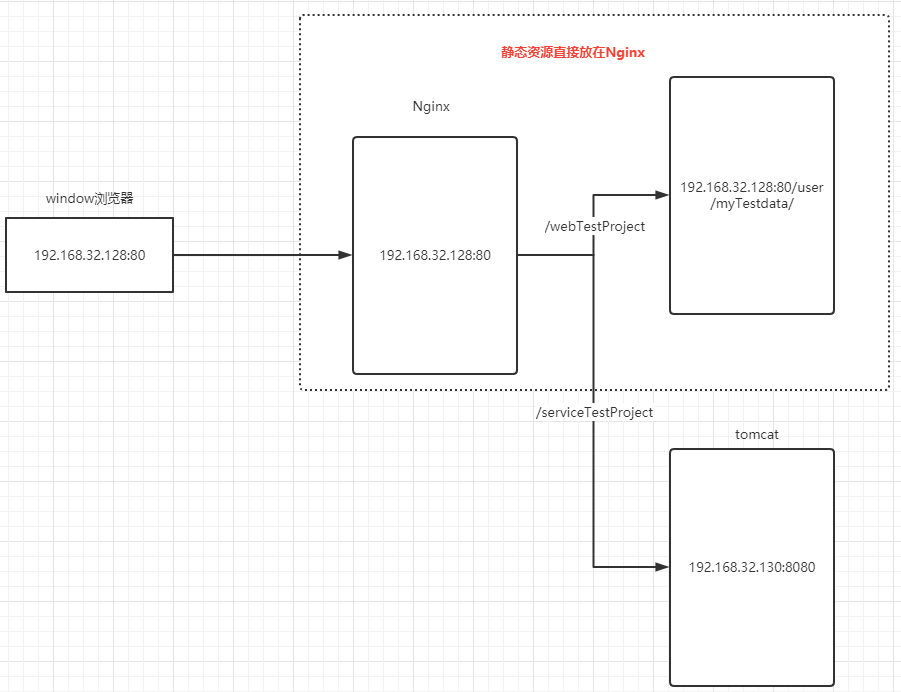Nginx配置动静分离
1、准备工作
我们最终想实现的效果如下:

即访问以 /webTestProject 为前缀的资源时,我们认为是静态资源。我们把静态资源直接放在 Nginx 服务器上,通过 Nginx 来直接返回静态资源。
当访问的资源以 /serviceTestProject 为前缀时,我们认为是动态资源。此时通过 Nginx 把请求代理转发至 192.168.32.130 服务器上,通过该服务器来处理动态请求。
上面也是常见的前后端分离项目的架构,实际上我们接下来的配置也是示例前后端分离在实际生产上的架构。
1.1、准备静态资源
首先先准备静态资源项目即前端项目 webTestProject,然后将该项目放到 192.168.32.128 服务器的 /usr/myTestData/webTestProject 目录下:

index.html 文件内容如下,只是显示一些简单内容发出求一个请求:
<!DOCTYPE html> <html lang="en"> <head> <meta charset="UTF-8"> <meta http-equiv="X-UA-Compatible" content="IE=edge"> <meta name="viewport" content="width=device-width, initial-scale=1.0"> <title>Document</title> </head> <body> <h1>Nginx练习页面</h1> <script> var xmlhttp; if (window.XMLHttpRequest) { // IE7+, Firefox, Chrome, Opera, Safari 浏览器执行代码 xmlhttp = new XMLHttpRequest(); } else { // IE6, IE5 浏览器执行代码 xmlhttp = new ActiveXObject("Microsoft.XMLHTTP"); } xmlhttp.onreadystatechange = function () { if (xmlhttp.readyState == 4 && xmlhttp.status == 200) { console.log(xmlhttp.responseText); } } //请求根路径下的/serviceTestProject/ajaxResponse.do,实际上会由Nginx转发至动态资源服务器 xmlhttp.open("GET", "/serviceTestProject/ajaxResponse.do", true); xmlhttp.send(); </script> </body> </html>
1.2、准备动态资源
我们新建一个简单的 maven javaweb 项目,并且建立一个 ajaxResponse.do 请求以供前端访问。
ajaxResponse.do 的代码如下:
@Controller public class ControllerTest01 { //直接给 ajax 请求返回字符串 @RequestMapping("/ajaxResponse.do") public void ajaxResponse(HttpServletRequest request, HttpServletResponse response) throws Exception{ PrintWriter out = response.getWriter(); out.write("hello"); } }
将该 web 项目打包,并且将打成的 war 包放在 192.168.32.130 服务器上的 tomcat 目录下的 webapps 目录下:

2、配置动静分离
将前端静态资源和后台动态资源分别部署到不同服务器上后,我们就可以开始进行配置了。
打开 192.168.32.128 服务器上的 Nginx 配置文件 /usr/local/nginx/conf/nginx.conf ,进行如下修改:

即监听本服务器上的 80 端口,当请求的资源以 /webTestProject 为前缀时,将请求直接转发至访问本服务器上 /usr/myTestData/ 目录下的资源,即直接将该目录下的静态资源返回。
当请求的资源以 /serviceTestProject 为前缀时,将请求转发至 192.168.32.130 服务器上,由该服务器来处理动态请求,我们将后台项目部署在了该服务器上。
配置完成后,我们可以在浏览器访问 http://192.168.32.128/webTestProject/index.html 可以看到如下效果:

ajaxResponse.do 请求:

可以看到 ajaxResponse.do 请求能正常访问,并不会有跨域问题。这是因为这些动态资源已经由 Nginx 进行了反向代理,虽然实际上是由 192.168.32.130 服务器进行处理并返回的,但浏览器并不能感知到。因为发出的动态资源请求是请求 192.168.32.128 服务器上的资源的,然后再由该服务器上的 Nginx 转发至 192.168.32.130 服务器上的。
实际上,动态资源是由 192.168.32.130 服务器处理并返回的,静态资源是由 192.168.32.128 上的 Nginx 服务器直接返回的。
2.1、完整的Nginx配置文件
完整的Nginx配置文件如下:
#user nobody; worker_processes 1; #error_log logs/error.log; #error_log logs/error.log notice; #error_log logs/error.log info; #pid logs/nginx.pid; events { worker_connections 1024; } http { include mime.types; default_type application/octet-stream; #log_format main '$remote_addr - $remote_user [$time_local] "$request" ' # '$status $body_bytes_sent "$http_referer" ' # '"$http_user_agent" "$http_x_forwarded_for"'; #access_log logs/access.log main; sendfile on; #tcp_nopush on; #keepalive_timeout 0; keepalive_timeout 65; #gzip on; server { listen 80; server_name 192.168.32.128; #charset koi8-r; #access_log logs/host.access.log main; location /webTestProject/ { root /usr/myTestData/; index index.html index.htm; } location /serviceTestProject/ { proxy_pass http://192.168.32.130:8080; root html; index index.html index.htm; } #error_page 404 /404.html; # redirect server error pages to the static page /50x.html # error_page 500 502 503 504 /50x.html; location = /50x.html { root html; } # proxy the PHP scripts to Apache listening on 127.0.0.1:80 # #location ~ \.php$ { # proxy_pass http://127.0.0.1; #} # pass the PHP scripts to FastCGI server listening on 127.0.0.1:9000 # #location ~ \.php$ { # root html; # fastcgi_pass 127.0.0.1:9000; # fastcgi_index index.php; # fastcgi_param SCRIPT_FILENAME /scripts$fastcgi_script_name; # include fastcgi_params; #} # deny access to .htaccess files, if Apache's document root # concurs with nginx's one # #location ~ /\.ht { # deny all; #} } # HTTPS server # #server { # listen 443 ssl; # server_name localhost; # ssl_certificate cert.pem; # ssl_certificate_key cert.key; # ssl_session_cache shared:SSL:1m; # ssl_session_timeout 5m; # ssl_ciphers HIGH:!aNULL:!MD5; # ssl_prefer_server_ciphers on; # location / { # root html; # index index.html index.htm; # } #} }


